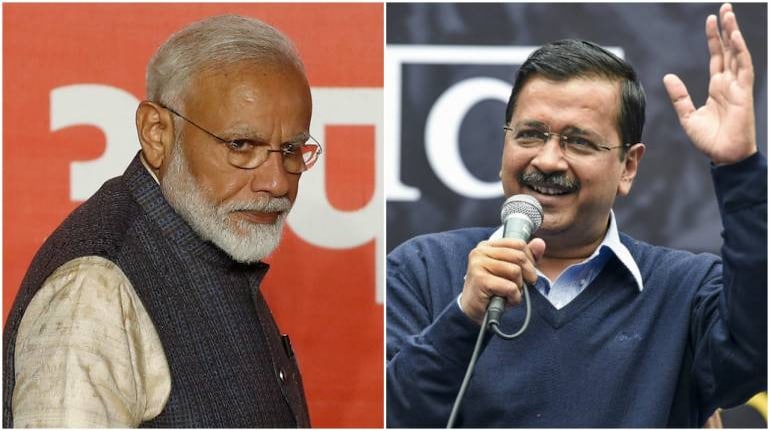



The tussle between Aam Aadmi Party and Bharatiya Janata Party seems to have no end in sight after the Centre brought an unprecedented ordinance retaking effective control of the national capital territory. The direct attack against the AAP makes one thing clear: The BJP is hellbent on stopping Arvind Kejriwal.
While this is a good opportunity for Kejriwal to break the ice with several opposition political parties and play an active role in uniting the opposition, the reality is that he has limited scope to make much of a difference in stopping the ordinance in the Rajya Sabha.
Why AAP?As Narendra Modi ascended to power in national politics, the BJP's narrative was constructed primarily in opposition to the Congress and other established regional parties. The political narrative of the BJP had no effective counter to a new party like the AAP. Even amidst the BJP's triumph and its unstoppable juggernaut between 2014 and 2019, the ascent of Arvind Kejriwal was a noteworthy development.
BJP’s critique of dynastic politics is invalidated in this case because the AAP is not a party run by a single family. In a similar vein, it is worth noting that the AAP's foundation was not rooted in any particular caste, regional, or religious ideology and had no baggage of policy missteps or bad governance.
Moreover, AAP has also successfully embraced both Hindutva (albeit a softer version) and nationalism. In the final analysis, it appears that the BJP is not yet equipped to contend with such a political party that leans towards the right of centre.
Kejriwal's political agenda is primarily focused on development and is characterised by a populist approach that emphasises the provision of freebies. More gallingly for BJP, Kejriwal’s freebies have received wide notice. Against these political pillars of the AAP, the BJP has so far been able to corner the AAP in only one area – corruption – and that is where control of Delhi government officials becomes important for the Centre.
The middle class and poor have been drawn to Kejriwal's brand of politics. From Delhi to Punjab, Gujarat, and Goa, there were numerous instances where disenchanted Congress voters are embracing AAP as a viable alternative rather than BJP supporters.
This helped Kejriwal's party quickly achieve the distinction of being a national party in a mere decade. Given the fewer weak points to attack AAP, BJP is not keen on allowing the AAP to flourish, gain traction, or emerge as a viable substitute for the Congress.
The central ordinance has the potential to create administrative hurdles and confusion within the Delhi government. However, it also presents a unique opportunity for Arvind Kejriwal to leverage it as a means to build bridges with opposition parties.
Since his entry into politics, Kejriwal has taken a confrontationalist approach towards opposition parties. He has not shared a cordial relationship with them; many still recall his scathing attacks on every political veteran and party, from Sharad Pawar to the Samajwadi Party.
Today, the landscape has shifted. Bihar Chief Minister Nitish Kumar, who has taken on the role of anchoring opposition unity, wasted no time in meeting with Kejriwal, and extending his support.
In a strategic move, Kejriwal is seizing the moment to reposition his party and demonstrate AAP's preparedness to join the opposition coalition. In an effort to secure backing from the opposition parties to block this ordinance in the Rajya Sabha, Kejriwal has begun to meet with several CMs and opposition leaders, including Uddhav Thackeray, Mamata Banerjee, and Sharad Pawar.
Beyond the immediate matter of the ordinance, these meetings present an opportunity for Kejriwal to expound upon his perspective regarding the opposition alliance and to initiate dialogue with other political factions.
The Congress PositionBut a focal point of concern lies in the tense dynamic between Kejriwal and the Congress party. To effectively thwart the ordinance, it is imperative that the Congress lends its support in the Rajya Sabha. Even with Congress support, the bill may still secure passage if “neutral” outfits such as BJD and YSRCP abstain from casting their votes.
Kejriwal has been adopting an amiable stance toward Congress. Following Rahul Gandhi's disqualification as Lok Sabha MP, Kejriwal was first among the opposition figures to speak out against BJP. Despite this, the Congress's state units in Delhi and Punjab have thus far been hesitant to align themselves with Kejriwal. It makes sense for Congress and AAP to reconcile for the present. Failure to oppose the ordinance will result in Kejriwal being unwilling to play second fiddle to the grand old party in 2024. Congress has an opportunity to make this a precondition for AAP’s cooperation in 2024.
Should Kejriwal fail to prevent the ordinance from passing in the Rajya Sabha, the legal battle will persist. However, the BJP has inadvertently provided Kejriwal with a powerful tool to galvanise opposition, foster inter-party communication, and garner public sympathy.
Sayantan Ghosh is a columnist and doctoral research scholar in media and politics. He tweets at @sayantan_gh. Views are personal and do not represent the position of this publication.Discover the latest Business News, Sensex, and Nifty updates. Obtain Personal Finance insights, tax queries, and expert opinions on Moneycontrol or download the Moneycontrol App to stay updated!
Find the best of Al News in one place, specially curated for you every weekend.
Stay on top of the latest tech trends and biggest startup news.